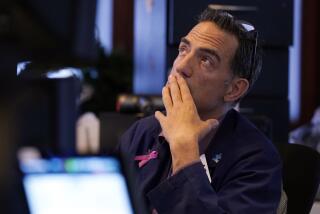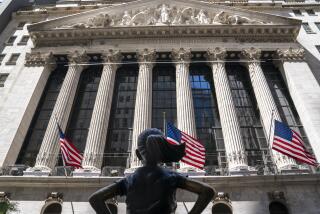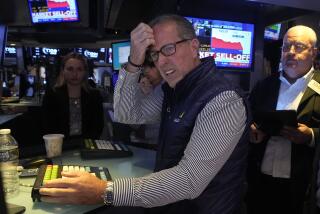Old-Timers Recall Crash of ‘29: ‘Nobody’s Out Selling Apples’
- Share via
Jacques Coe, who at 94 is still active in the securities business, remembers leaving his New York office for three hours to buy a picture on the day the stock market crashed in 1929.
“When I got back, everybody was scared that I had jumped out of a window. But why would I? I was out of the market by then,” said Coe, now a partner in Cowen & Co. in New York.
This time around, Coe claims that he and his clients sold their holdings before disaster hit.
Like Coe, some in the coterie of veterans of the last market crash who are still on Wall Street had a feeling in their bones that history was going to repeat itself. When it did, many of them were already out of the market.
Those seasoned traders and brokers see some similarities between Monday’s stock market collapse and the debacle of October, 1929, but they also note that the economy is much stronger today and that shareholders can no longer buy stocks “on margin,” with little money down.
In 1929, George H. Earnest was a trader on the old Los Angeles “curb” exchange, a secondary exchange that operated in the basement below the regular stock exchange. During Monday’s crash, the 79-year-old was heading the trading desk at C. McKinney & Co., a regional brokerage based in Los Angeles.
“This is my second time around,” Earnest said. “We survived those days. Of course it was easier for me. I was only 21 years old and I had a good strong nervous system.”
Earnest said he has been bearish on the market since early spring and unloaded some of his holdings in March and April.
“I thought the market was too high,” he said.
Coe vividly recalls one customer in 1929 in the board room at his brokerage house standing up on the railing shouting: “Sell, sell. Sell everything!”
The panic, he said Tuesday, was not as intense in this drop as it was then.
“Nobody has gotten wiped out yet,” Coe said. He attributed that fact to current requirements that prevent investors from paying for more than 50% of their stock with borrowed money. In 1929, investors could pay for as much as 90% of the cost of their stock with borrowed funds.
Melvin Belli, the flamboyant lawyer, visited the San Francisco floor of the Pacific Stock Exchange on Monday and pronounced it “much more orderly” than the scene he witnessed 58 years ago when he was marking stock prices on a chalkboard at a local brokerage firm.
“I remember, Jesus, in the morning when the stuff started to go down there was hysteria in the room,” the 80-year-old Belli said. “I could hear people swearing in Italian. They wanted to shoot the guys marking the board like it was all our fault.”
Belli noted that he owns no stock. “I don’t gamble on anything but the jury,” he said.
Despite the relative calm that surrounded the latest plunge, Coe thinks that there are many parallels between this sudden drop in the stock market and that of 1929.
“I have been bearish for two years because of the similarities,” he said.
“It’s not the Tokyo market, it’s not interest rates. It’s over-speculation on the part of the public,” Coe said.
“There was no cushion under the market then and there is no cushion under the market today.”
Not all of the experienced hands on Wall Street, however, see that many parallels with 1929. For instance, I. W. (Tubby) Burnham II, now honorary chairman of Drexel Burnham Lambert, said there is “no comparison between the 1929 drop and the 1987 drop.”
“1929 looks like small potatoes compared to what happened this week,” said Burnham, then a “board boy” who wrote prices on blackboards with chalk as they changed at the Frank B. Cahn brokerage in Baltimore.
Burnham, 78, who went on to found Burnham & Co., a predecessor of Drexel Burnham Lambert, said: “This is so much bigger in terms of total involvement of the world and the marketplace.
Built-in Safeguards
“It will be proved that this was much more serious because of the options trading, programmed trading, index trading and insurance trading. They accentuated this collapse,” he said.
Nevertheless, Burnham said: “Today we have so many built-in safeguards. We have unemployment insurance, welfare, Medicare, Medicaid. I remember bread lines and 25% unemployment, mostly due to the collapse of the banking system after the collapse of the market. I don’t see that resulting from what is going on now.”
Lucien O. Hooper, a director of research for a Wall Street firm at the time of the crash, said that the computer is what has made the two stock market dives different.
Small Investors Vulnerable
“In 1929,” the 91-year-old vice president at Thomson McKinnon Securities said, “the ticker ran till 10 at night. It was a half-day late instead of just two or three hours. We had to work all night and weekends and some of us did not get home for two weeks. You wouldn’t believe the errors that were made.”
Furthermore, Hooper said, small investors were particularly vulnerable to a downturn in 1929.
“There was no Social Security and everybody was heavily in debt personally. With 10% margin, if a stock went down 10% you were broke. Everybody owed more on their homes, too. If you had a $10,000 home, you might owe $6,000 to $8,000 on it. The ratio is not as unfavorable as that (today). Now most people have a large equity in their homes.”
Today, he said, “general conditions are better. More of these companies are earning good money, paying dividends, that sort of thing. In 1929, we didn’t have an SEC; we didn’t have an NASD; we didn’t have anything like that. Now we have all types of rules and regulations.”
Stanley Schiff, a vice president and director of Drexel Burnham, was a young telephone clerk on the floor of the exchange in October, 1929.
Monday’s wild trading was nothing like the 1929 nose dive, he maintains.
“This was a market decline,” Schiff said. “In 1929 it was a Depression. I don’t see anyone out there now selling apples.”
More to Read
Sign up for Essential California
The most important California stories and recommendations in your inbox every morning.
You may occasionally receive promotional content from the Los Angeles Times.










